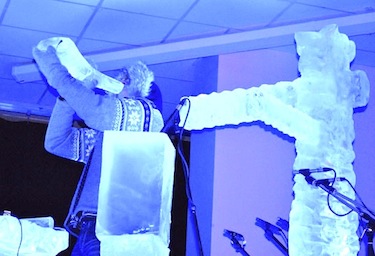Norway’s ice musician captivates Nunavut audience
Terje Isungset: “this is the sound of your ice”

Ice musician Terje Isungset plays one of his ice horns at his Feb. 19 concert at Iqaluit’s Inuksuk High School. (PHOTO BY JANE GEORGE)
Here’s a way to calm rowdy kids: play Terje Isungset’s ice music for them.
Two boys, aged eight or nine, did not fidget or even once make a sound throughout the Feb. 19 performance of ice music by the acclaimed Norwegian musician and composer at Iqaluit’s Inuksuk High School.
Like others in the packed space, they sat transfixed by Inungset’s 40-minute set on a stage full of ice-carved columns and other contraptions. At the same time, Isungset showed how ice carved from an Iqaluit lake can produce a surprising range of sounds.
These resulted from Isungset rubbing ice shavings with a piece of ice, scraping piles of shaved ice with his foot across a block of ice, banging a large ice block like a drum, playing slabs of ice across an ice box and tapping on ice chimes suspended from a tall ice scaffold.
And then there were the horns: three of them, played one after the other.
The first horn resemble a horn. The next looked like a kind of ice tuba with a large cone at the opening, and the third looked like a saxophone.
The sounds? These ranged from wind-like sounds to calls from birds or wolves, thanks to the horns’ kazoo properties, which let Isungset control the sounds with a mouth harp (which some in the audience said reminded them of the ones that Inuit use).
But the concert wasn’t just about sounds. Isungset’s rhythms, accompanied by Mari Kvein Brunvoll’s haunting melodies, had a shape of their own.
The last work (which Isungset did not name) saw him playing wild beat-box-like tunes on the saxaphone-like horn, with Brunvoll’s voice in the background. Joyous and a bit scary, it sounded like the kind of song ice would sing if it had a voice.
“This is the sound of your ice,” Isungset told the audience. And it’s a sound he called “fantastic”.
Isunget added that making music on ice, from water, the world’s most important resource, always remains an honour.
By the end of his performance, the ice was dripping off the scaffold, which, like Isungset’s other instruments, were all created in Iqaluit by his ice instrument maker, Bill Covitz. T
he instruments were quickly whisked away into cold storage so that Isungset can record some music in and around Iqaluit, outside, before he leaves for the south and his next performances at the Kennedy Center in Washington, D.C.
As for the boys who sat as still as the ice on stage during the entire ice music concert, at the end of the evening, they came out of their reverie and scampered off.
The audience also included three co-workers from the Government of Nunavut, relative newcomers to the capital city, who said they attend all cultural events in the city — and this one, the kind their friends in Toronto envied, they couldn’t miss.
Isungset drew a representative cross-section of Iqaluit to the Feb. 19 performance: there were several babies, many young residents under 30, both Inuit and non-Inuit, local Francophones, longtime Iqaluit residents and a few elders — the kind of audience that the Alianait arts festival does not always get for its shows.
Isunget’s performance, the first of Alianait’s 2013 concert series, also received assistance from the Royal Norwegian Embassy in Canada.





(0) Comments